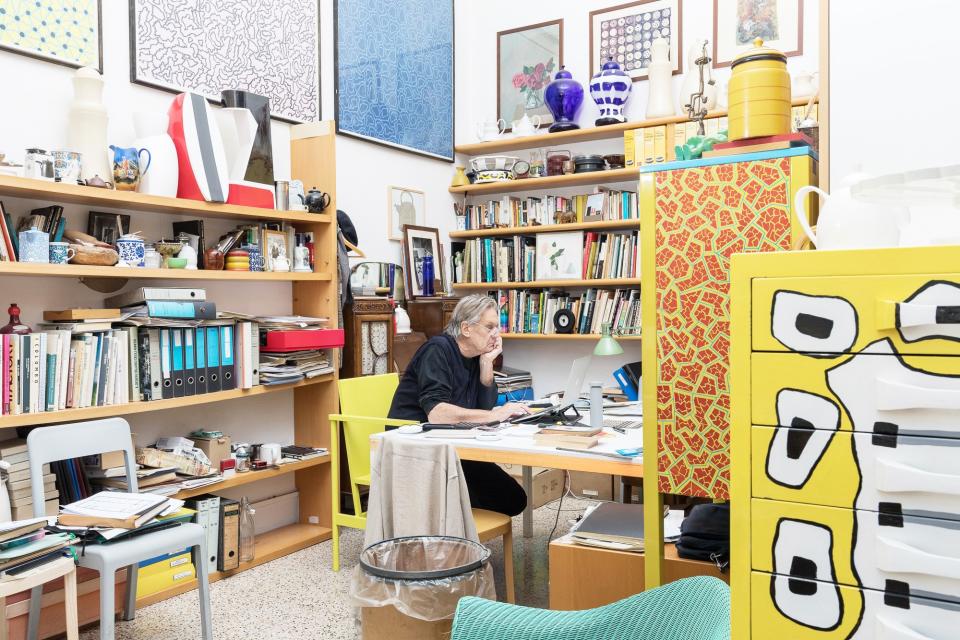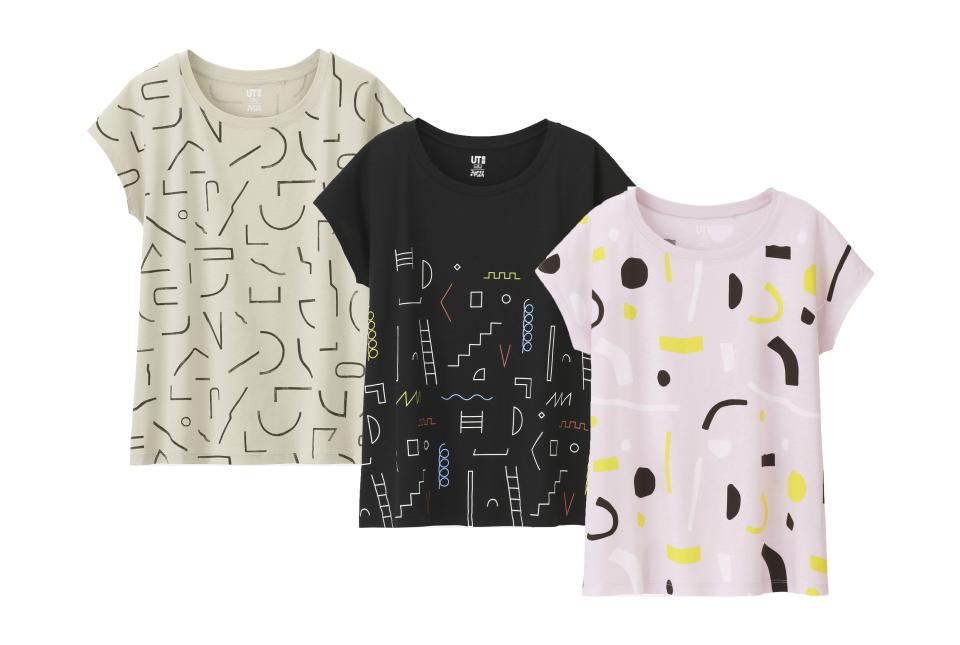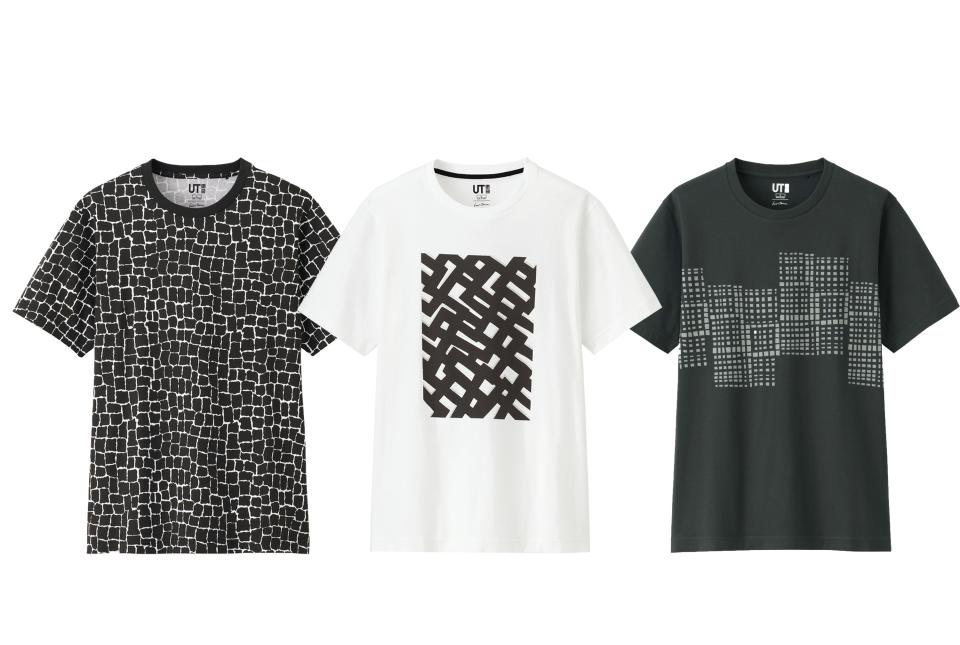Ellen Van Dusen and George Sowden Unveil Collaboration with UNIQLO
What do Keith Haring, Andy Warhol, Sol LeWitt, and Charles and Ray Eames have in common? They've all had their work printed on T-shirts for UT, UNIQLO's cult T-shirt line. Now, two pattern-loving design stars join the roster. Rising Brooklyn-based talent Ellen Van Dusen and Milan-based legend George Sowden. Van Dusen, whose eye-popping patterns have been printed across everything from dresses and bed linens to a classic pair of Keds, has long admired the work of the U.K.-born Sowden, a cofounder of the Memphis Group in 1981. "His use of color and whimsy opened up the world for designers like me to make things a little weirder and more chaotic," she explains. So when the Japanese retailer tapped both for a collection of patterned tees called Supergeometric (it is available at uniqlo.com and in select stores starting April 8), Van Dusen caught up with her design hero to talk color theory, collaborating, and what makes a great design object.
Ellen Van Dusen: How did you get your start in the design world?
George Sowden: I started work as a designer in 1970. Electronics did not exist and decoration was not part of what was generally called design. In those years I produced drawings, made experimental works, and began research related to my idea for the renewal of decoration in design. Today a large part of my work is related to decoration, as well as to the design of electronic products.
EVD: How do you approach projects differently when designing collaboratively versus on your own? Do you prefer one to the other?
GS: Design is always a collaborative process with the team in my office and with the manufacturers or artisans responsible for the making of the project.
EVD: Who do you align yourself with in other artistic fields?
GS: I'm curious about how ideas generate and move across disciplines, how this may have changed over time, with the advent of the Internet, etc. I am very interested in music but I wouldn’t say that I aligned myself in any particular way—music, art, fashion, and design underline feelings in society and we interact with that. When I came to Milano in 1970 I was very much part of the Grateful Dead ambience; now I am more inclined to be interested in very talented artists, such as Baby Dee, working outside of the commercial studios.

EVD: How has your design aesthetic changed over the course of your career?
GS: The big difference in what I did as a young man and what I do now can be measured by changes in technology. I do not think that my sensitivity toward visual things has changed so much over the years; maybe it became calmer.
EVD: I'm interested in your approach to color. Is it a gut feeling or do you have a set of rules you like to follow?
GS: I do not have rules about color. I either close my eyes and look for the one I see in my mind's eye, or, if I am in a hurry, I choose the pencil nearest to me from the box of 24. For industrial products we will select from the thousands in the Pantone selection or NCS references, but I always work from a hunch or pick from my favorite colors, which I have used over and over again.
EVD: Do you think differently about designing a pattern for clothing and designing a pattern for furniture or objects?
GS: No, I think that pattern is a simple, direct communication, which can exist on its own without a reason or a function, used only for added sensation.
EVD: I know that you create art as well as designed objects. Where do you draw the line between the two?
GS: I am a designer, not an artist. Anything I exhibited as a one-off or unique piece I consider to be research and part of my own collection of personal references for future work.

EVD: What are your interests outside of design?
GS: I was a curious child and I am a curious person—it is the quantity of so many electronic images, printed images, which we simultaneously consume in seconds as we turn the page of a magazine or glance distractedly to the other side of the street, that fascinates me. Do we ever see the same thing twice?
EVD: Anything you're particularly interested in at the moment?
GS: Ecology and our environment. I wish I could do more to help.
EVD: Do you follow any young designers?
GS: I see a lot of things that I like done by young people that are fast, that depend on diversity, that are constructed from small fragments of ideas. I try to follow as much as I can.
EVD: What's your favorite thing you've ever designed?
GS: It doesn’t exist.

EVD: Do you live with your own products?
GS: We live with our prototypes, samples, and experiments.
EVD: Do you have a favorite designed object?
GS: The teapot is one of the best inventions ever.
EVD: How involved are you in the manufacturing end of your work?
GS: I have spent my whole working life in factories. In China I became a tourist of manufacturing facilities. I love factories for the many different kinds of people and the experience it gives me—not just meeting the owners, but the people working. I find it to be a very educative experience, not only from a practical point of view that helps me with my work, but also as a social, humanist, and anthropological experience.
EVD: What was different about working on the UNIQLO collection versus some of your other collaborative projects?
GS: UNIQLO knew exactly what they wanted and chose patterns from my archive. Everything was decided quickly.
More from AD PRO: Has Instagram Made Design Shows Better?
Sign up for the AD PRO newsletter for all the design news you need to know

